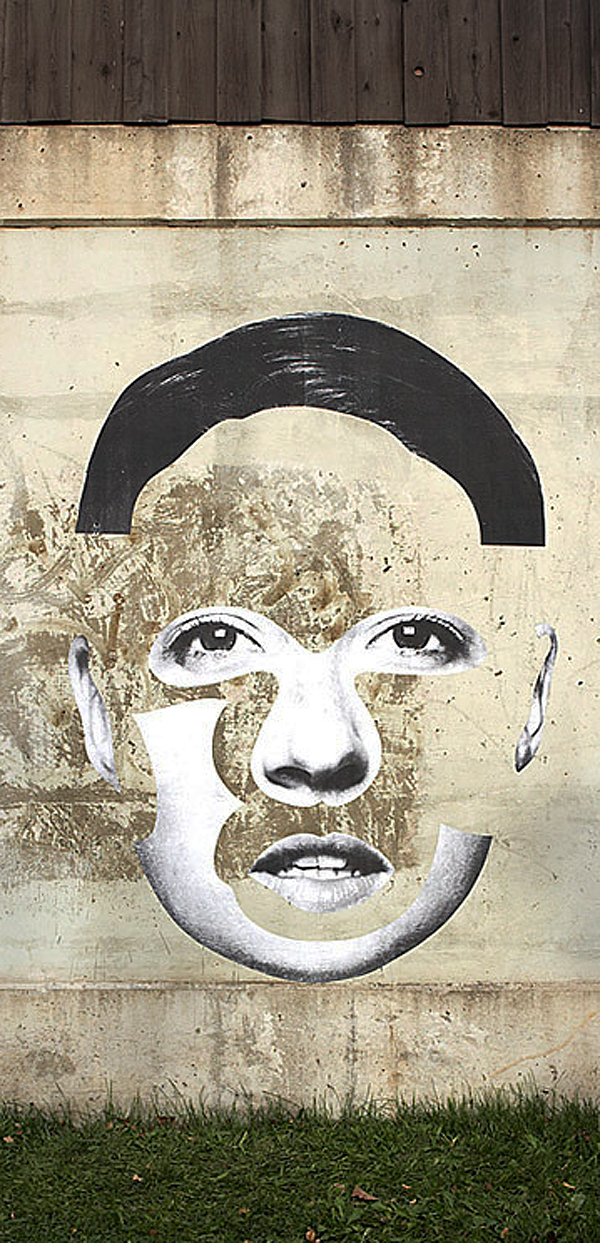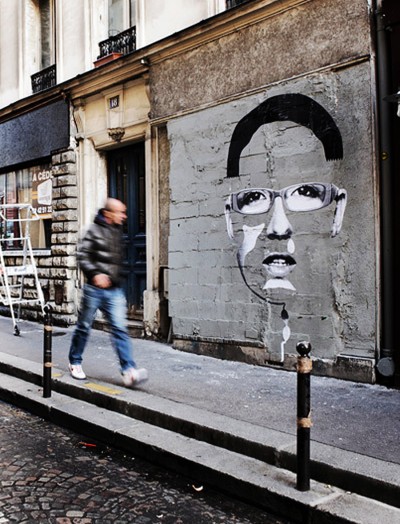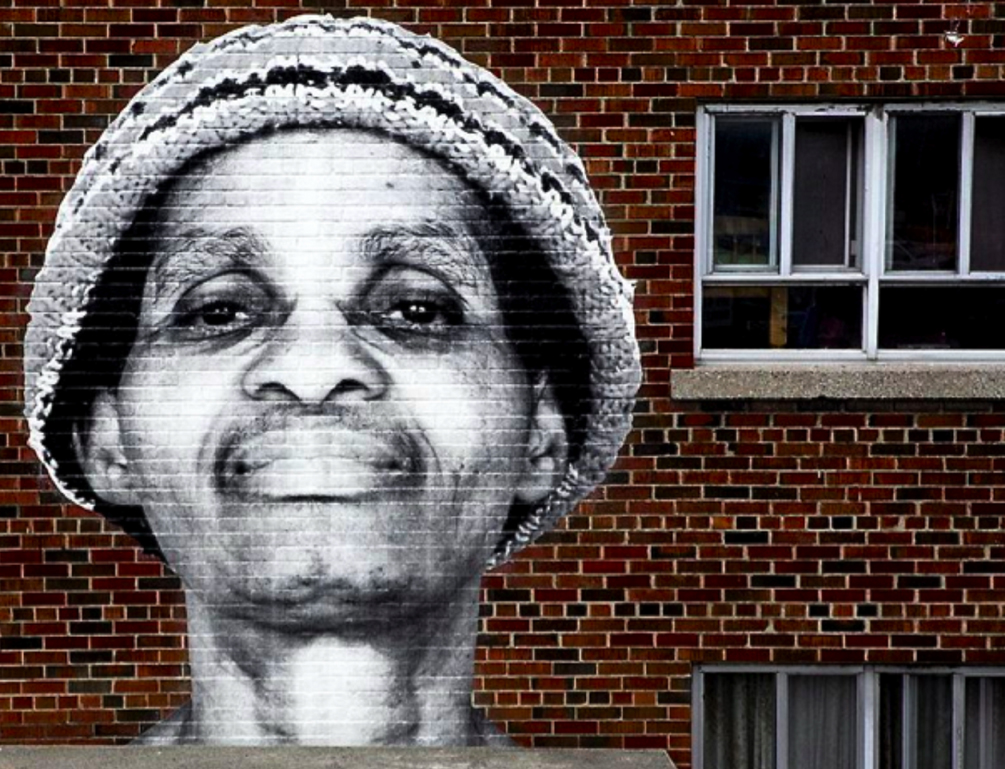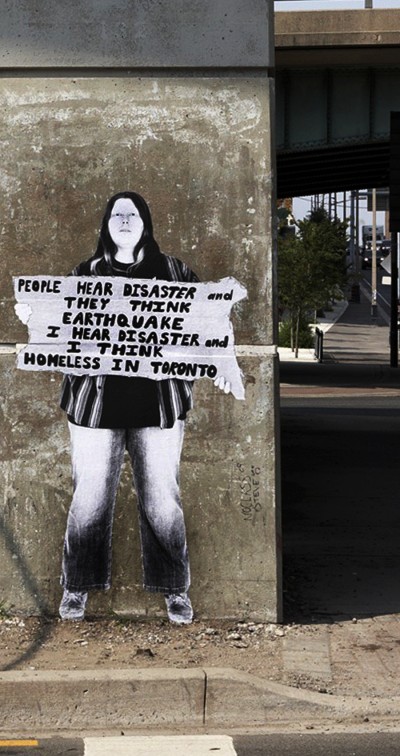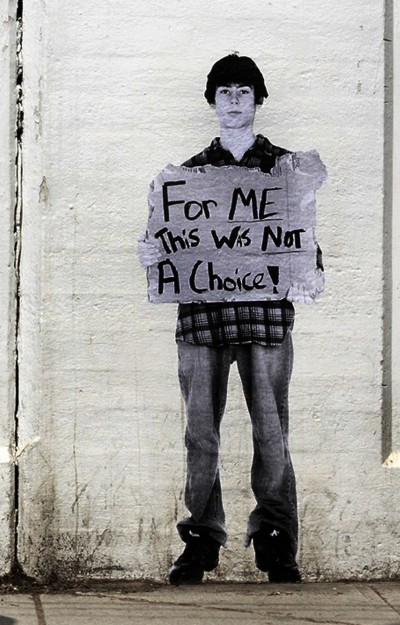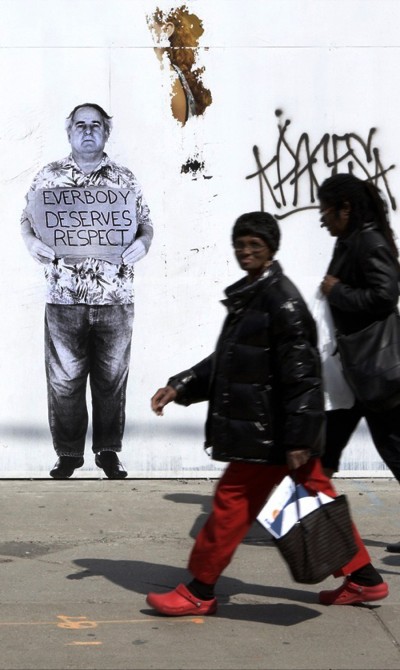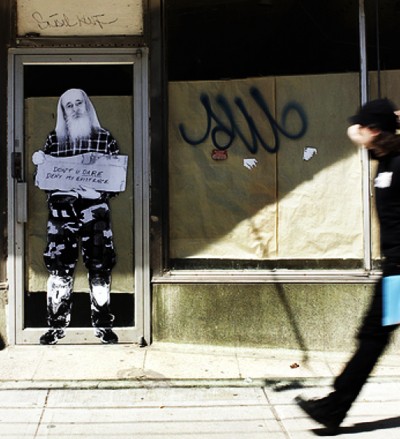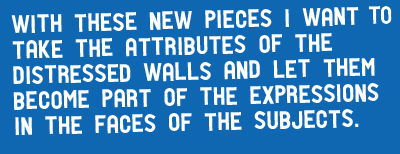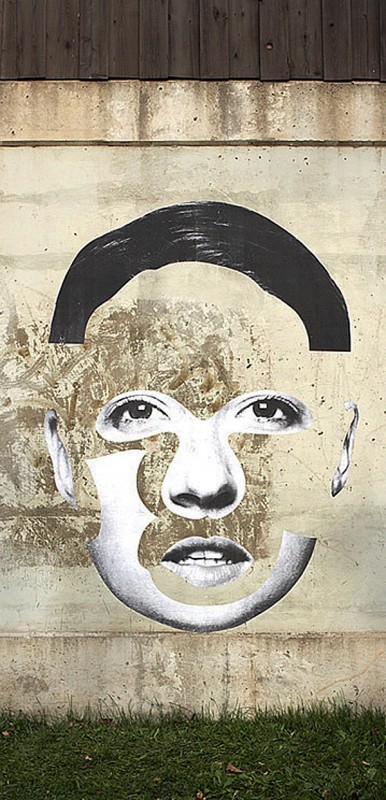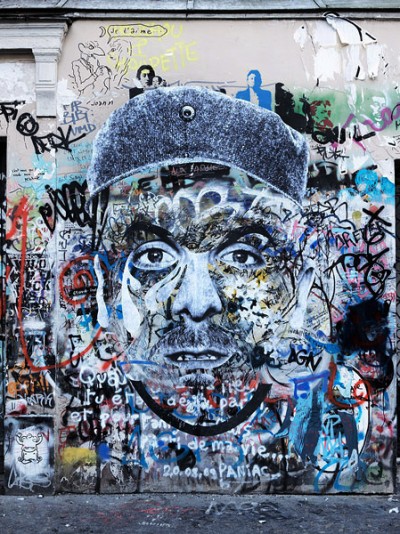Facing the Public Can Be a Huge Challenge for a Street Artist. Fauxreel has no problem looking you in the eye (and heart).
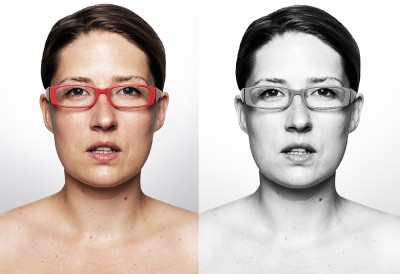
Street Artist Fauxreel shows BSA some of the images he uses to create his new “Face in the City” series.
Dan Bergeron, AKA Fauxreel, has been bringing realistic-looking people to the street for about a decade. Using photography, sociology, and psychology, the Toronto-based artist likes to pay homage, increase visibility, and give voice to people we may not usually see or hear. Time and again he returns to issues of social justice and the individuals who he sees have been overlooked or outright ignored by our greater society on some level.
Fauxreel’s work is deliberate, thoughtful, careful and heartfelt. A great amount of study and preparation takes place before any piece is finally up, as if doing less would be dishonest. His newest project is a departure from these heavier sentiments and takes a step back from social policy. Instead his portraits seek to fuse with the walls, camoflauge themselves with graffiti and weathered brick. In these partially missing portraits, the topic of invisibility is addressed yet again, but this time with more poetry and a bit of mystery.
As usual, Fauxreel is putting his best face forward, and following it up with action. Here he talks with BSA about three of his most recent projects and what motivates him to hold a mirror up before us.
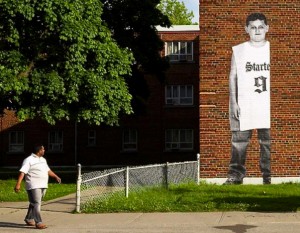
Fauxreel selected people who lived in this public housing project and created huge portraits for the buildings in the complex. (photo Dan Bergeron)
Brooklyn Street Art: When we last spoke with you, you were working on a large project in a public housing area in Toronto (The Regent Park Portrait Project). Was that a good experience for you and the residents?
Fauxreel: It’s hard to speak for all of the residents of the Regent Park community, but the ones that I did keep in touch with were very happy to either have participated as subjects or to have a positive spotlight shone on their community. Did the project help residents in terms of being displaced from their community? No. Although no concrete outcome emerged from installing the images, I think that a lot of Torontonians got out to visit Regent Park when they normally wouldn’t have and with the help of Luminato (the festival that commissioned the project) there will be a new arts center built when the redevelopment is completed.
Personally, the project was rewarding for a number of reasons. The scale of the work was a challenge to create and install. I had gone 10′ high before, but doubling the size made me tighten up both my shooting and pasting skills.
The impact the work had (and still has as I still get e-mails from people who have just discovered it) made me realize that my work can have merit, can exist for the greater good and not just in an anti-establishment sort of way. But most importantly the project was rewarding and memorable for the people that I met and the process involved in its undertaking.
Brooklyn Street Art: Recently you have been working on a project called “The Unaddressed”. Similar to the other project, it contemplates people who are marginalized by our society.
Fauxreel: The Unaddressed project came about through a commission I received from The Royal Ontario Museum and The Contact Photography Festival. The exhibition was entitled Housepaint Phase II: Shelter. Devon Ostrom curated the exhibition and The ROM chose to work with 5 artists – Evoke, Other, Elicser, Specter and myself. The other four artists chose to work with interpreting structures in accordance with the theme of homelessness. As such, I thought I would work to my strength and focus on people. Over four months I spent time meeting various homeless and formerly homeless residents of Toronto.
Brooklyn Street Art: This time out, you gave people placards with messages – a bit more direct way of getting the idea across?
Fauxreel: In completing research for this project, I read a book called Dying For A Home by Cathy Crowe, who’s a street nurse living and working in Toronto. Through reading the book I got the impression that to combat an issue like homelessness you have to be very much in other people’s faces.
Never insult people or chastise them for their fortune in life, but definitely talk about the homeless situation as directly as possible. Be frank and be honest. As such, I thought that using panhandling signage for the subjects to convey their messages was as simple and straightforward as you can get. So I brought the subjects over to my studio, we chatted about their experiences and they came up with messages that they wanted to convey to the public; messages that were counter to what is usually seen on most panhandling signage today.
In the end, the signs revealed some of the issues surrounding homelessness, showed the public that some necessities that we take for granted (think about having a phone or identification) are actually quite valuable and hard to come by and they allowed the subjects to speak their minds.
Brooklyn Street Art: Why do you think we walk right by people in need without seeing them?
Fauxreel: Unfortunately we ignore many things, people and situations in life as a pure means of survival. I’m definitely guilty of it. Imagine if you were to walk to work everyday and stop and chat, give money or help everyone that needed it. You wouldn’t get to work on time, you would feel pretty depressed and you would have a little less money in your pocket. And because reasons for being homeless are so complex – drug addictions, mental illness to name a few – it’s often hard for the average person to reach out to someone in a situation like this. That being said, we shouldn’t ignore others in need in order for our own perseverance, but we should try and find a balance between giving of our time or money to individuals and organizations that need are help and working towards our passions and goals. I think someone once said that it’s easier to give of yourself when your cup is full.
Brooklyn Street Art: Can you talk about one of the individuals you worked with, and how the process evolved?
Fauxreel: I met a lot of the subjects through Andy Coats, a family friend who works with Project 417 here in Toronto. Project 417 is responsible for sandwich runs, providing clothing and specifically working with homeless youth, amongst many other efforts. Andy was able to introduce me to a number of homeless youth through a weekly meal drop in at Knox Presbyterian Church. With Andy as a liaison, I was able to meet a bunch of great folks and help them get their messages out.
Of the 18 people who’s photograph that I took, I think spending time with Ron Craven was the most illuminating. Ron is a former successful real estate agent who became a hard drug user in the early 80’s, lost it all and ended up on the street. The interesting thing about talking to Ron is that he’s lived all of these different lives and he understands the value of money and property in ways that most people don’t, whether they are homeless or not. Although many people liken real estate agents to the devil, it’s people like Ron who get to see the joy that people feel when they purchase a home. So to hear Ron talk about life on the streets is a definite eye opener.
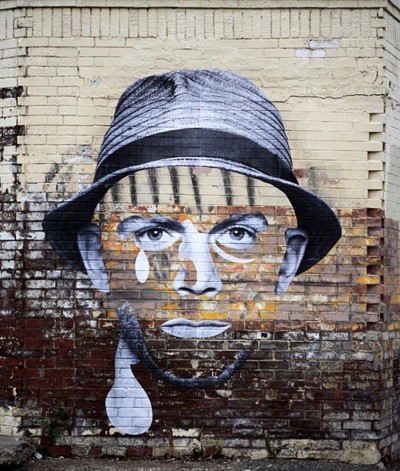
Integrating the exposed and weathered brick wall as an element of the face in the city, Fauxreel loosens the grip for a ghostly effect. The new works “explore the idea that beauty truly lies in the scars, wrinkles and blemishes of places we live and people we meet”
Brooklyn Street Art: Today you are working on some pieces that are bit more abstract…almost like the head of an invisible man…
Fauxreel: “The Unaddressed” project took a lot out of me and I really didn’t want to create work outdoors for a while. The reaction to the work in Toronto was not very favorable. A lot of the pieces got ripped down and/or defaced with rude comments directed at the subjects. Although looking back, it shows that the work resonated enough with the public that they reacted to it.
With this new body of work (“Face of the City”) I’m trying to take on some ideas that I’ve come to develop through spending time with Specter. As you may know, he and I worked on “A City Renewal Project” last year and we are really great friends.
Whenever we talk about new work the discussion always comes back to the work being site-specific. With these new pieces I want to take the attributes of the distressed walls and let them become part of the expressions in the faces of the subjects. It makes the work somewhat three-dimensional in a way and is allowing me to loosen my style and approach up a bit.
The work is in it’s infant stages at the moment, but I think that the ideas behind the work have a universal appeal, will allow me to experiment with a bunch of different techniques and approaches, and it’s a body of work that I think I could continue to work on here and there for years to come.
Brooklyn Street Art: How do you try to create work that can speak to viewers?
Fauxreel: To speak to viewers I think you need to be sensitive to them and their interests. If you’re working outdoors, then you need to look at issues of public space, look at how people communicate with one another, realize how the work can help people to understand others and themselves and always be keen to pay attention to where the work is going to reside. Other than that I would only say that you should try and be original and create work that has some substance. Without substance there is no purpose or longevity.
Brooklyn Street Art: You’ve talked in the past of a communal living room. Is that how you see the environment of the street?
Fauxreel: Definitely. The outdoors is a communal space and as an artist working outdoors I should try and make work that provokes the viewer to think or heighten the viewer’s experience of the outdoors when they come into contact with my work.
Brooklyn Street Art: How does your work affect you?
Fauxreel: Finding this venue to express myself has been the most rewarding experience in my life thus far. It makes me feel like I’m contributing to a larger conversation and has given me a vocation in which I can express my ideas.
<<< << >> >> > < < < > > > > >
 BROOKLYN STREET ART LOVES YOU MORE EVERY DAY
BROOKLYN STREET ART LOVES YOU MORE EVERY DAY